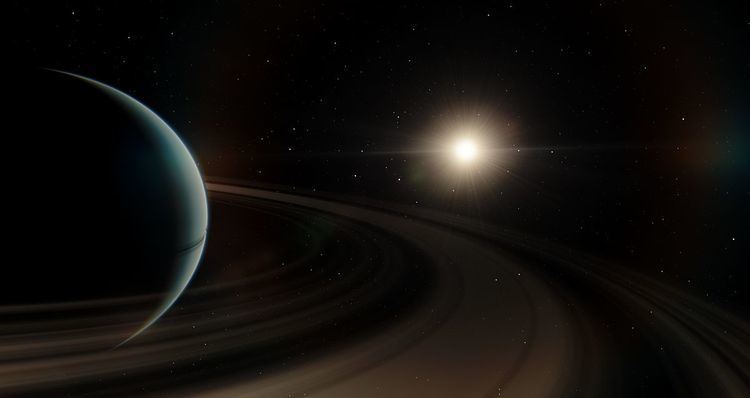[Fe/H] 0.10 (± 0.07) Discoverer(s) Niedzielski et al. Discovery status Published | Discovery date June 10, 2009 Discovery site La Silla Observatory | |
 | ||
BD+14°4559 b is an exoplanet orbiting the K-type main sequence star BD+14°4559 about 158 light-years (48 parsecs, or nearly 7015150000000000000♠1.5×1015 km) from Earth in the constellation Pegasus. It orbits its star within the habitable zone at a distance of 0.777 AU, close to that of Venus, but its star is less energetic, thus its habitable zone is closer to it than Earth. The exoplanet was found by using the radial velocity method, from radial-velocity measurements via observation of Doppler shifts in the spectrum of the planet's parent star.
Contents
Mass, radius and temperature
BD+14°4559 b is a gas giant, an exoplanet that has a radius and mass around that of the gas giants Jupiter and Saturn. It has a temperature of 205 K (−68 °C; −91 °F). It has an estimated mass of around 1.2 MJ and a potential radius of around 1.05 RJ based on its mass.
Host star
The planet orbits a (K-type) star named BD+14°4559. The star has a mass of 0.86 M☉ and a radius of around 0.95 R☉. It has a surface temperature of 5008 K and is likely about 3 billion years old based on its evolution and mass. In comparison, the Sun is about 4.6 billion years old and has a surface temperature of 5778 K.
The star's apparent magnitude, or how bright it appears from Earth's perspective, is 9.63. Therefore, BD+14°4559 is too dim to be seen with the naked eye, but can be viewed using good binoculars.
Orbit
BD+14°4559 b orbits its star with about 25% of the Sun's luminosity every 268 days at a distance of 0.77 AU (close to Venus's orbital distance from the Sun, which is 0.72 AU). It has a mildly eccentric orbit, with an eccentricity of 0.29.
Habitability
BD+14°4559 b resides in the habitable zone of the parent star. The exoplanet, with a mass of 1.47 MJ, is too massive to likely be rocky, and because of this the planet itself may not be habitable. Hypothetically, large enough moons, with a sufficient atmosphere and pressure, may be able to support liquid water and potentially life. However, such moons do not usually form around planets, they would likely have to be captured from afar; e.g., a protoplanet running astray.
For a stable orbit the ratio between the moon's orbital period Ps around its primary and that of the primary around its star Pp must be < 1/9, e.g. if a planet takes 90 days to orbit its star, the maximum stable orbit for a moon of that planet is less than 10 days. Simulations suggest that a moon with an orbital period less than about 45 to 60 days will remain safely bound to a massive giant planet or brown dwarf that orbits 1 AU from a Sun-like star. In the case of BD+14°4559 b, the orbital period would have to be no greater than a month (28–29 days) in order to have a stable orbit.
Tidal effects could also allow the moon to sustain plate tectonics, which would cause volcanic activity to regulate the moon's temperature and create a geodynamo effect which would give the satellite a strong magnetic field.
To support an Earth-like atmosphere for about 4.6 billion years (the age of the Earth), the moon would have to have a Mars-like density and at least a mass of 0.07 M⊕. One way to decrease loss from sputtering is for the moon to have a strong magnetic field that can deflect stellar wind and radiation belts. NASA's Galileo's measurements hints large moons can have magnetic fields; it found that Jupiter's moon Ganymede has its own magnetosphere, even though its mass is only 0.025 M⊕.
Discovery
The search for BD+14°4559 b started when its host star was chosen an ideal target for a planet search using the radial velocity method (in which the gravitational pull of a planet on its star is measured by observing the resulting Doppler shift), as stellar activity would not overly mask or mimic Doppler spectroscopy measurements. It was also confirmed that BD+14°4559 is neither a binary star nor a quickly rotating star, common false positives when searching for transiting planets. Analysis of the resulting data found that the radial velocity variations most likely indicated the existence of a planet. The net result was an estimate of a 1.47 MJ planetary companion orbiting the star at a distance of 0.77 AU with an eccentricity of 0.29.
Radial velocity measurements of BD+14°4559 were measured at 43 epochs over the period of roughly 1,265 days (around 4 years) using the Hobby–Eberly Telescope. Measurements determined that a signal-to-noise ratio per resolution element was around 150–260 at 594 nm in 10 to 25 minutes of integration. The estimated mean RV uncertainty for the parent star was estimated at 8 m s−1.
The discovery of BD+14°4559 b was reported in the journal The Astrophysical Journal on June 10, 2009.
